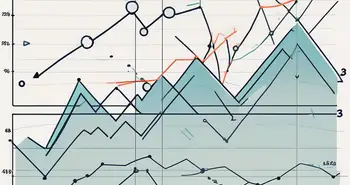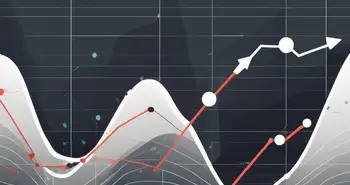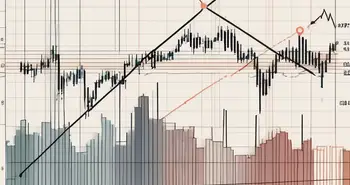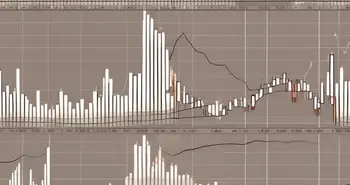Uncovering the Island Reversal Pattern: What You Need to Know

In the world of trading, there are numerous patterns and signals that can help investors make informed decisions. One such pattern that holds significant importance is the Island Reversal Pattern. If you're eager to boost your trading skills and increase your understanding of the market, then this article is for you. Let's delve into the basics of the Island Reversal Pattern and explore its many facets.
Understanding the Basics of Island Reversal Pattern
Before we dive into the intricacies of the Island Reversal Pattern, let's first define what it actually is. An Island Reversal Pattern is a technical analysis formation that signifies a potential reversal in the direction of a trend. It is characterized by a gap on both sides, isolating a period of trading activity, hence the name ‘island.'
The structure of the Island Reversal Pattern consists of a gap in the price movement, followed by a series of candles that fail to fill the gap. This pattern suggests a shift in investor sentiment and can often lead to a substantial price reversal in the opposite direction.
Traders often look for Island Reversal Patterns as a signal to potentially enter or exit a trade. The formation of an island suggests a period of indecision in the market, with buyers and sellers struggling for control. As the pattern unfolds, it can provide valuable insights into the balance of power between bulls and bears.
It is important to note that not all Island Reversal Patterns lead to a significant trend reversal. Some may result in a temporary pause or consolidation before the prevailing trend resumes. Traders use additional technical indicators and analysis to confirm the validity of the pattern and make informed trading decisions.
The Significance of Island Reversal Pattern in Trading
Predicting market reversals is the holy grail of trading, and the Island Reversal Pattern plays a critical role in achieving this goal. By identifying this pattern, traders can gain valuable insights about potential trend reversals and adjust their trading strategies accordingly.
The reliability of the Island Reversal Pattern varies from case to case. Sometimes, it serves as a strong indication of an impending reversal, while in other instances, it may lead to false signals. It is essential to exercise caution and apply astute supplementary analysis to ensure accurate predictions.
One key characteristic of the Island Reversal Pattern is the formation of a gap. This gap signifies a disconnect in trading activity, often caused by a sudden shift in market sentiment or a significant news event. Traders closely monitor the size and nature of this gap to gauge the strength of the potential reversal.
Furthermore, the duration of the island formation is crucial in determining the pattern's significance. A more prolonged separation of prices from the surrounding trading range tends to indicate a more robust reversal signal. Traders analyze the length of this isolation period to assess the sustainability of the upcoming price movement.
Identifying the Island Reversal Pattern
Now that you understand the significance of the Island Reversal Pattern, let's focus on the key characteristics that can help you identify it with confidence.
One primary characteristic to look out for is a substantial gap in the price movement, followed by a series of candles or bars that fail to fill the gap. This isolated period of trading activity creates a clear separation, resembling a tiny island amidst the vast ocean of price movements.
Novice traders often make mistakes in identifying the Island Reversal Pattern. It is crucial to avoid premature judgements and ensure that the pattern is confirmed through additional technical analysis tools or indicators. Combining multiple signals can significantly enhance the accuracy of your predictions.
Another important aspect to consider when analyzing the Island Reversal Pattern is the volume of trading during the formation of the pattern. A decrease in trading volume leading up to the gap and a subsequent increase in volume when the price starts to reverse can provide further confirmation of the pattern.
Additionally, it is essential to pay attention to the overall market conditions and any significant news events that may have influenced the price movement. External factors can play a crucial role in the validity and strength of the Island Reversal Pattern.
Strategies for Trading with Island Reversal Pattern
Now that you can identify the Island Reversal Pattern, it's time to discuss effective strategies for trading based on this pattern.
Timing is key when it comes to entering and exiting trades using the Island Reversal Pattern. The best entry point is typically after the pattern is confirmed by additional indicators, ensuring a higher probability of success. As for the exit point, it is wise to set a predetermined target or employ trailing stop orders to lock in profits while still allowing room for potential price movements.
Risk management is an integral part of any trading strategy, and the Island Reversal Pattern is no exception. It is essential to establish appropriate stop-loss orders to protect against unexpected price fluctuations. Maintaining a disciplined approach and adhering to risk management practices can make a significant difference in your overall trading success.
Furthermore, it's crucial to consider the overall market conditions when trading based on the Island Reversal Pattern. Market trends, volatility, and key support and resistance levels can all impact the effectiveness of this pattern. By conducting a thorough analysis of the broader market environment, traders can make more informed decisions and increase their chances of success.
Another important aspect to keep in mind is the psychological aspect of trading. Emotions such as fear and greed can cloud judgment and lead to impulsive decisions. Developing a trading plan with clear entry and exit points, as well as risk management rules, can help traders stay disciplined and avoid making emotional trades based on short-term market fluctuations.
The Limitations of Island Reversal Pattern
While the Island Reversal Pattern holds valuable insights, it's important to acknowledge its limitations to make well-informed trading decisions.
False signals are not uncommon with the Island Reversal Pattern. Traders must exercise caution and validate the pattern with additional technical analysis tools to increase the probability of accurate predictions.
Supplementary analysis is crucial when it comes to trading with the Island Reversal Pattern. Relying solely on this pattern may not provide a comprehensive view of the market. Combining it with other technical indicators, such as moving averages or volume analysis, can greatly enhance your trading strategy.
Moreover, it's essential to consider the broader market context when interpreting the Island Reversal Pattern. External factors like economic news, geopolitical events, or market sentiment can significantly impact the pattern's effectiveness. Being aware of these external influences can help traders avoid potential pitfalls and make more informed decisions.
Additionally, understanding the historical performance of the Island Reversal Pattern in different market conditions is crucial. Backtesting the pattern across various time frames and asset classes can provide valuable insights into its reliability and effectiveness. This empirical approach can help traders fine-tune their strategies and adapt to changing market dynamics.
FAQ
What is the Island Reversal Pattern?
The Island Reversal Pattern is a technical analysis formation characterized by a gap in the price movement, followed by a series of candles that fail to fill the gap. It suggests a potential reversal in the direction of a trend.
How reliable is the Island Reversal Pattern?
The reliability of the Island Reversal Pattern varies. While it can serve as a strong indication of a trend reversal, it can also produce false signals. It is essential to supplement its analysis with additional technical indicators.
What are the key characteristics of the Island Reversal Pattern?
The key characteristics of the Island Reversal Pattern include a substantial gap in the price movement followed by a series of candles that fail to fill the gap. This isolated period of trading activity resembles a small island amidst the vast ocean of price movements.
How should I trade with the Island Reversal Pattern?
When trading with the Island Reversal Pattern, it is crucial to time your entry and exit points effectively. Confirm the pattern with additional technical indicators before entering a trade. Establish appropriate stop-loss orders and employ risk management practices to protect your capital.
What are the limitations of the Island Reversal Pattern?
False signals and the need for supplementary analysis are the main limitations of the Island Reversal Pattern. Relying solely on this pattern may lead to inaccurate predictions. Combining it with other technical indicators can provide a more comprehensive view of the market.
In conclusion, the Island Reversal Pattern is a powerful tool in any trader's arsenal. By unlocking the secrets of this pattern, traders can gain valuable insights into potential market reversals. Remember to exercise caution, validate the pattern with additional analysis, and implement effective risk management to enhance your trading success.
Ready to put the Island Reversal Pattern into action? Discover the future of trading with Morpher, the innovative platform that's changing the game with zero fees, infinite liquidity, and the flexibility of fractional investing. Whether you're looking to trade stocks, cryptocurrencies, or even unique markets, Morpher's blockchain technology offers you a unique trading experience with up to 10x leverage and the safety of a non-custodial wallet. Don't miss out on this opportunity to elevate your trading strategy. Sign Up and Get Your Free Sign Up Bonus today and join the revolution at Morpher.com!

Disclaimer: All investments involve risk, and the past performance of a security, industry, sector, market, financial product, trading strategy, or individual’s trading does not guarantee future results or returns. Investors are fully responsible for any investment decisions they make. Such decisions should be based solely on an evaluation of their financial circumstances, investment objectives, risk tolerance, and liquidity needs. This post does not constitute investment advice.

Painless trading for everyone
Hundreds of markets all in one place - Apple, Bitcoin, Gold, Watches, NFTs, Sneakers and so much more.

Painless trading for everyone
Hundreds of markets all in one place - Apple, Bitcoin, Gold, Watches, NFTs, Sneakers and so much more.









